Chapter: Electromagnetic Theory
Electrodynamic fields
Electrodynamic
fields
Introduction:
In our
study of static fields so far, we have observed that static electric fields are
produced by electric charges, static magnetic fields are produced by charges in
motion or by steady current. Further, static electric field is a conservative
field and has no curl, the static magnetic field is continuous and its
divergence is zero. The fundamental relationships for static electric fields
among the field quantities can be summarized as:

In this
chapter we will consider the time varying scenario. In the time varying case we
will observe that a changing magnetic field will produce a changing electric
field and vice versa.
We begin
our discussion with Faraday's Law of electromagnetic induction and then present
the Maxwell's equations which form the foundation for the electromagnetic
theory.
Faraday's Law of electromagnetic
Induction
Michael
Faraday, in 1831 discovered experimentally that a current was induced in a
conducting loop when the magnetic flux linking the loop changed. In terms of
fields, we can say that a time varying magnetic field produces an electromotive
force (emf) which causes a current in a closed circuit. The quantitative
relation between the induced emf (the voltage that arises from conductors
moving in a magnetic field or from changing magnetic fields) and the rate of
change of flux linkage developed based on experimental observation is known as
Faraday's law. Mathematically, the induced emf can be written as
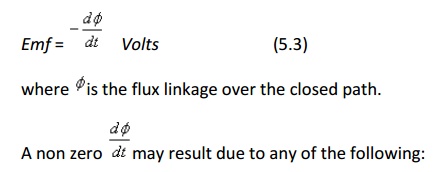
(a) time changing flux linkage a
stationary closed path.
(b) relative motion between a steady flux
a closed path.
(c) a combination of the above two cases.
The
negative sign in equation (5.3) was introduced by Lenz in order to comply with
the polarity of the induced emf. The negative sign implies that the induced emf
will cause a current flow in the closed loop in such a direction so as to
oppose the change in the linking magnetic flux which produces it. (It may be
noted that as far as the induced emf is concerned, the closed path forming a
loop does not necessarily have to be conductive).
If the
closed path is in the form of N tightly wound turns of a coil, the change in
the magnetic flux linking the coil induces an emf in each turn of the coil and
total emf is the sum of the induced emfs of the individual turns, i.e.,
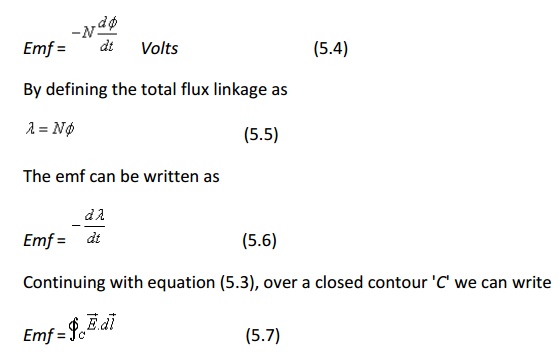
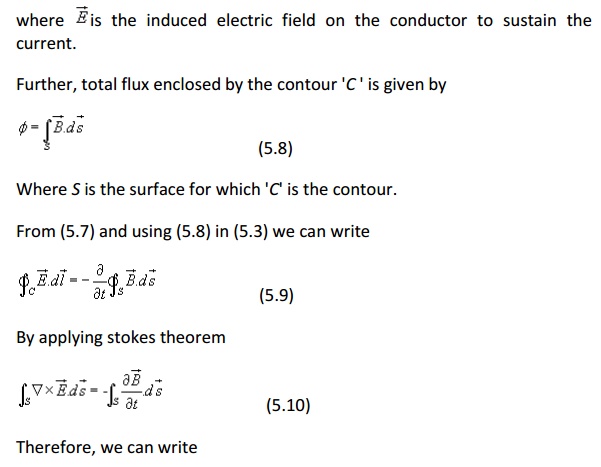

which is
the Faraday's law in the point form
We have
said that non zero dϕ/dt can be produced in a several ways.
One particular case is when a time varying flux linking a stationary closed
path induces an emf. The emf induced in a stationary closed path by a time
varying magnetic field is called a transformer
emf .
Example: Ideal transformer
As shown
in figure 5.1, a transformer consists of two or more numbers of coils coupled
magnetically through a common core. Let us consider an ideal transformer whose
winding has zero resistance, the core having infinite permittivity and magnetic
losses are zero.

These
assumptions ensure that the magnetization current under no load condition is
vanishingly small and can be ignored. Further, all time varying flux produced
by the primary winding will follow the magnetic path inside the core and link
to the secondary coil without any leakage. If N1 and N2
are the number of turns in the primary and the secondary windings respectively,
the induced emfs are
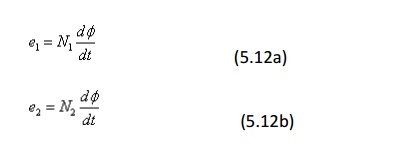
(The
polarities are marked, hence negative sign is omitted. The induced emf is +ve
at the dotted end of the winding.)

i.e.,
the ratio of the induced emfs in primary and secondary is equal to the ratio of
their turns. Under ideal condition, the induced emf in either winding is equal
to their voltage rating.

where 'a' is the transformation ratio. When the
secondary winding is connected to a load, the current flows in the secondary,
which produces a flux opposing the original flux. The net flux in the core
decreases and induced emf will tend to decrease from the no load value. This
causes the primary current to increase to nullify the decrease in the flux and
induced emf. The current continues to increase till the flux in the core and
the induced emfs are restored to the no load values. Thus the source supplies
power to the primary winding and the secondary winding delivers the power to
the load. Equating the powers
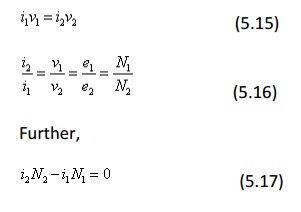
i.e.,
the net magnetomotive force (mmf) needed to excite the transformer is zero
under ideal condition.
Motional EMF:
Let us
consider a conductor moving in a steady magnetic field as shown in the fig 5.2.

This
force will cause the electrons in the conductor to drift towards one end and
leave the other end positively charged, thus creating a field and charge
separation continuous until electric and magnetic forces balance and an
equilibrium is reached very quickly, the net force on the moving conductor is
zero.

A
classic example of motional emf is
given in Additonal Solved Example No.1 .
Maxwell's Equation
Equation
(5.1) and (5.2) gives the relationship among the field quantities in the static
field. For time varying case, the relationship among the field vectors written
as

The equation 5.20 (a) - (d) must be consistent with equation (5.21).
We observe that

A classic example for this is given below . Suppose we are in the process of charging up a capacitor as shown in fig 5.3.

Let us
apply the Ampere's Law for the Amperian loop shown in fig 5.3. Ienc = I is the total current
passing through the loop. But if we draw a baloon shaped surface as in fig 5.3, no current passes through this
surface and hence Ienc =
0. But for non steady currents such as this one, the concept of current
enclosed by a loop is ill-defined since it depends on what surface you use. In
fact Ampere's Law should also hold true for time varying case as well, then
comes the idea of displacement current which will be introduced in the next few
slides.
We can
write for time varying case,
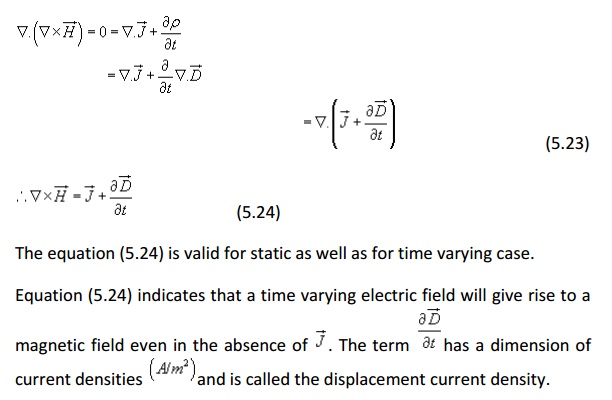
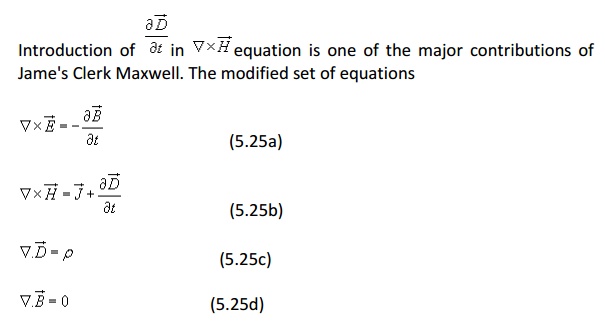
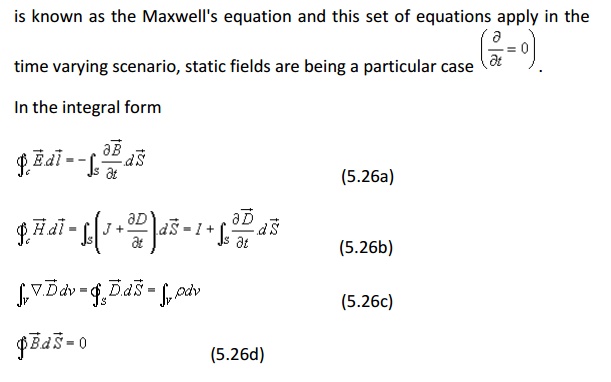
The
modification of Ampere's law by Maxwell has led to the development of a unified
electromagnetic field theory. By introducing the displacement current term,
Maxwell could predict the propagation of EM waves. Existence of EM waves was
later demonstrated by Hertz experimentally which led to the new era of radio
communication.
Boundary Conditions for
Electromagnetic fields
The
differential forms of Maxwell's equations are used to solve for the field
vectors provided the field quantities are single valued, bounded and
continuous. At the media boundaries, the field vectors are discontinuous and
their behaviors across the boundaries are governed by boundary conditions. The
integral equations(eqn 5.26) are assumed to hold for regions containing
discontinuous media.Boundary conditions can be derived by applying the
Maxwell's equations in the integral form to small regions at the interface of
the two media. The procedure is similar to those used for obtaining boundary
conditions for static electric fields (chapter 2) and static magnetic fields
(chapter 4). The boundary conditions are summarized as follows
With
reference to fig 5.3
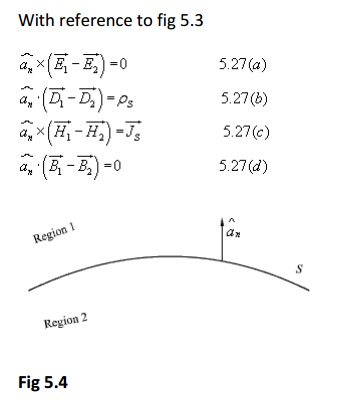
Equation 5.27 (a) says that tangential component of electric field is continuous across the interface while from 5.27 (c) we note that tangential component of the magnetic field is discontinuous by an amount equal to the surface current density. Similarly 5.27 (b) states that normal component of electric flux density vector D(Bar) is discontinuous across the interface by an amount equal to the surface current density while normal component of the magnetic flux density is continuous. If one side of the interface, as shown in fig 5.4, is a perfect electric

Wave equation and their solution:
From equation 5.25 we can write the Maxwell's equations in the differential form as
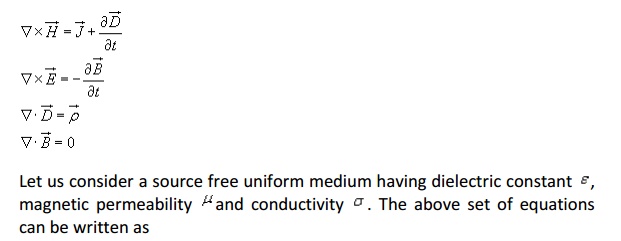

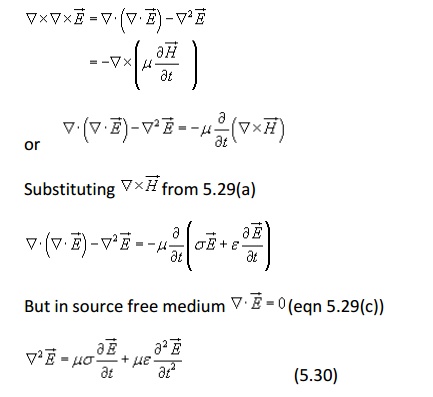
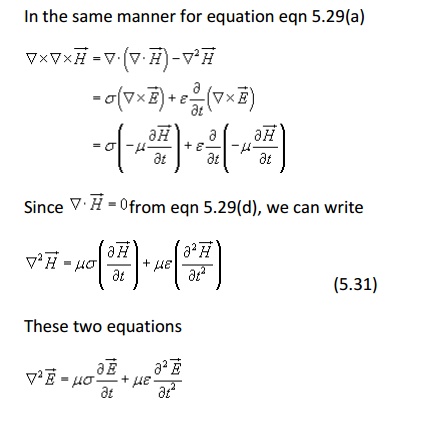
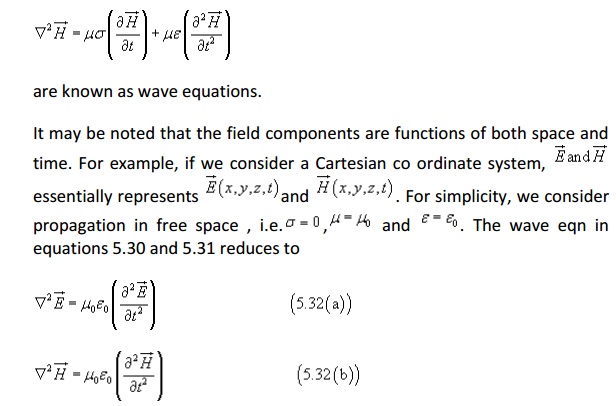
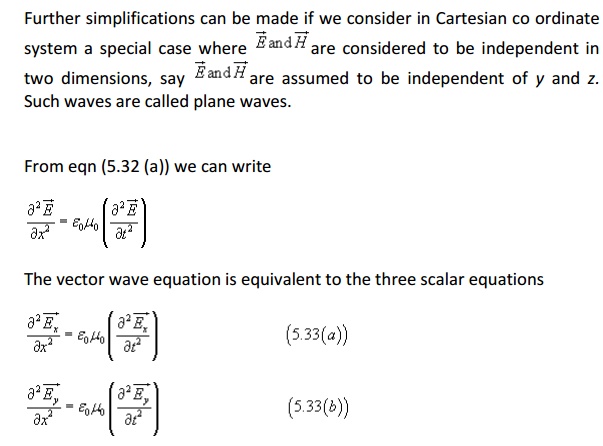
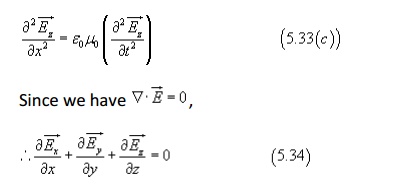
As we
have assumed that the field components are independent of y and z eqn (5.34)
reduces to
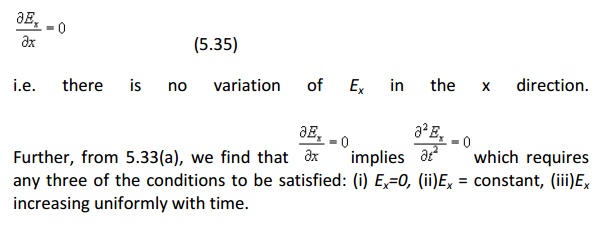
A field
component satisfying either of the last two conditions (i.e (ii) and (iii))is
not a part of a plane wave motion and hence Ex
is taken to be equal to zero. Therefore, a uniform plane wave propagating in x
direction does not have a field component (E
or H) acting along x.
Without
loss of generality let us now consider a plane wave having Ey component only (Identical results can be obtained for
Ez component) .
The
equation involving such wave propagation is given by
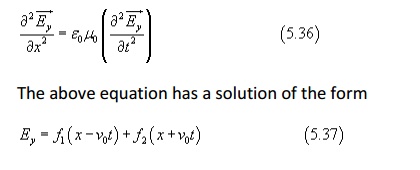
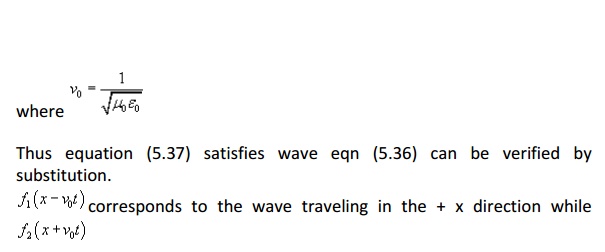
corresponds
to a wave traveling in the -x direction. The general solution of the wave eqn
thus consists of two waves, one traveling away from the source and other
traveling back towards the source. In the absence of any reflection, the second
form of the eqn (5.37) is zero and the solution can be written as

Such a
wave motion is graphically shown in fig 5.5 at two instances of time t1
and t2.
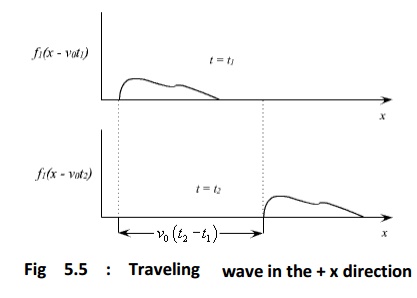
Let us
now consider the relationship between E and H components for the forward
traveling wave.
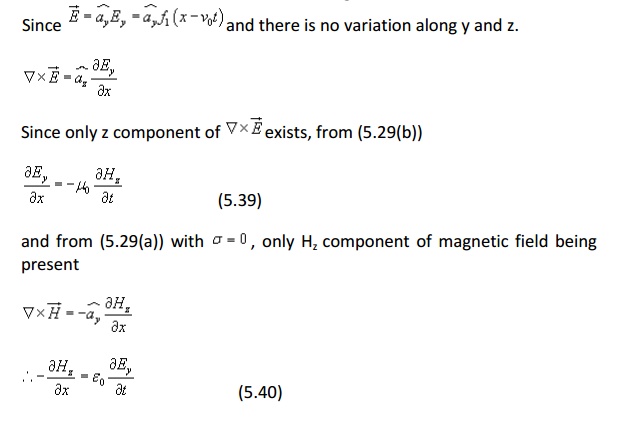
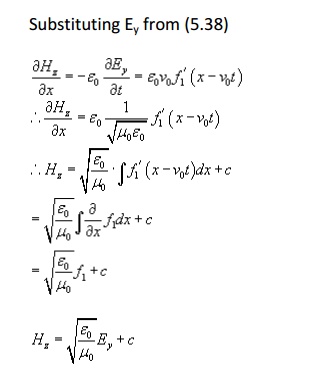
The
constant of integration means that a field independent of x may also exist.
However, this field will not be a part of the wave motion.

which
relates the E and H components of the traveling wave.

is
called the characteristic or intrinsic impedance of the free space
ASSIGNMENT
PROBLEMS
